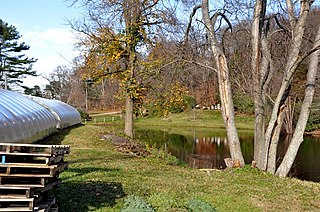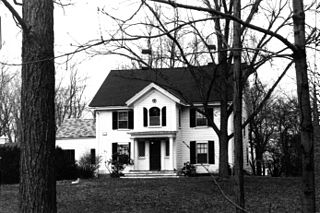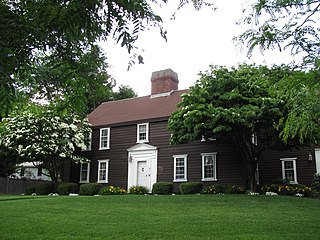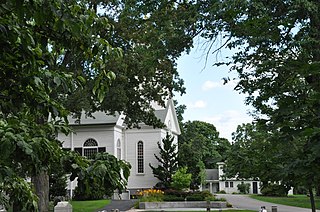
The Jeremiah Lee Mansion is a historic house located in Marblehead, Massachusetts. It is operated as a house museum by the local historical society. Built in 1768, it was designated a National Historic Landmark in 1960 as one of the finest Late Georgian houses in the United States. It features original wallpaper and finely-crafted woodwork.

Allandale Farm, also known as the John Harris House and Farm, and once as Faulkner Farm, is an historic farm at 284 Newton Street in Chestnut Hill, Massachusetts. The main farm house, built c. 1778 and extensively remodeled in 1976, is one of Brookline's few 18th-century houses. The farm is the last working farm in both communities; it was added to the National Register of Historic Places in 1985.

The Lower Highlands Historic District encompasses one of the oldest residential areas of Fall River, Massachusetts. The district is roughly bounded by Cherry, Main, Winter, and Bank Streets, and is located just east of the Downtown Fall River Historic District and directly south of the Highlands Historic District. This area was settled by 1810, has architecture tracing the city's growth as a major industrial center. The historic district was added to the National Register of Historic Places in 1984.

The Samuel Gardner House is a historic colonial American house in Swansea, Massachusetts. This 1+1⁄2-story wood frame gambrel-roofed house was built c. 1768 by Samuel Gardner, whose father was the first English colonist to settle Gardner's Neck after its purchase from local Native Americans. It is a well-preserved 18th century farmhouse.

The Eaton-Moulton Mill is a historic industrial building at 37 Walnut Street in the Wellesley Lower Falls village of Wellesley, Massachusetts. The 2+1⁄2-story granite mill building was built c. 1853 by the firm of Reuben Ware and William Clark, manufacturers of papermaking machinery. The building is distinctive for its use of stone, a relatively uncommon construction material in this area. The Lower Falls area of Wellesley and Newton developed as a papermaking center in the 18th century, and began transitioning from handmade methods to machine methods producing rolls of paper in the 1830s. Ware and Clark were at the forefront of this transition, establishing a machine shop in 1832 where the manufactured equipment for this new process. This building was built for them in 1853, and continued under Eaton and Moulton and other owners until papermaking declined. The building now houses commercial office space.

The Clark–Eames House is a historic house located at 230 Middlefield Road in Washington, Massachusetts. Probably built around 1790, it is one of the town's few surviving 18th-century houses. It was listed on the National Register of Historic Places in 1986.

The William Murray House is a historic First Period house on the east side of Salem, Massachusetts. It is a two-story wood-frame house that consists of two distinct sections that have not always been treated as a single unit. Its construction history provides a window into 17th and 18th century building methods. The westernmost section was built c. 1688, and is three window bays wide and a single room in depth. The eastern section, also three bays wide and one room deep, was added in the late 17th or early 18th century. The western portion originally had an overhanging section of the second floor; this was altered in the early 18th century, when the roof was raised to a flatter pitch and the overhanging section was concealed by construction of a flush wall.

The George Robbins House is a historic First Period house in Carlisle, Massachusetts. Although construction of the oldest portions of this house generally ascribed to George Robbins in c. 1660–70, stylistic analysis of its construction methods places its date of construction to c. 1700. It is a timber-frame house, five bays wide; its leanto is a late 18th-century addition, and the ell on the house's left dates to the 19th century, when some Greek Revival styling was added.

The Williams–Linscott House was a historic First Period house at 357 William Street in Stoneham, Massachusetts. The oldest part of the house was said to date to c. 1712, but it is unclear to which part of the house this referred, on account of major alterations the house in the 18th and 19th centuries. It is believed to have begun as a four-room two-story structure built around a central chimney. This underwent significant alteration during the Federal period, including replacing the center chimney with smaller side chimneys, and the construction of four more rooms in front of the original four. Sometime around 1850 Micah Williams, a prosperous farmer, again refashioned the house in the then-popular Italianate style.

The Fuller–Bemis House is a historic house at 41–43 Cherry Street in Waltham, Massachusetts, United States. The 2+1⁄2-story wood-frame house was built c. 1776, and is one of Waltham's few 18th century houses. It was built when the south side, where it is located, was still part of Newton. It was converted into a two-family structure in the 19th century. Its relatively plain Georgian styling sets it apart from the later 19th century housing that surrounds it.

The Hammond House is an historic house located at 9 Old Orchard Road in the village of Chestnut Hill in Newton, Massachusetts. With an estimated construction date of 1645-1730, it is believed to be the oldest house in Newton. It is also a rare example of a First Period house that was started as a single cell, that was expanded to five bays later in the First Period; such expansion usually took place later in the 18th century, during the Georgian period. The house has been extended multiple times over the intervening centuries; the original core now lies just east of the main entrance. The original house was built by Hon. Ebenezer Stone when he moved from the Stone homestead at Mount Auburn in Watertown.

The house at 173–175 Ward Street in Newton, Massachusetts is one of the city's few federal style houses. Built c. 1800, it is a 2+1⁄2-story wood-frame structure with clapboard siding and twin rear wall chimneys. The house has a five-bay facade with windows framed by narrow moulding. The main entrance is flanked by paired pilasters surrounding sidelight windows, topped by an entablature. The house was built by Charles Hyde and was involved in property disputes attending the construction of tunnels in the area in the mid-19th century.

The Samuel Jackson Jr. House is a historic house located at 137 Washington Street in Newton, Massachusetts.

The Kingsbury House is a historic house at 137 Suffolk Street in the Chestnut Hill section of Newton, Massachusetts. The oldest part of this 2+1⁄2-story timber frame may have been built as early as 1686; its exterior styling suggests a construction date in the early 18th century, but the earlier structure may have been incorporated in new construction at that time. The house is one a few First Period houses in Newton, and was associated for many years in the 19th century with the Kingsbury family, who were major landowners in the Chestnut Hill area.

The Newton Lower Falls Historic District encompasses the historic colonial village center of Newton Lower Falls, on the west side of Newton, Massachusetts. This area lies north of Washington Street, along Concord and Grove Streets, between Washington and Hagar Streets. The district was listed on the National Register of Historic Places in 1986.

The Old Chestnut Hill Historic District encompasses the historic residential heart of the Newton portion of Chestnut Hill, Massachusetts. When first listed on the National Register of Historic Places in 1986, the district extended along Hammond Street, between Beacon Street and the MBTA Green Line right-of-way, and along Chestnut Hill Road between Hammond and Essex, including properties along a few adjacent streets. The district was expanded in 1990 to include more of Chestnut Hill Road and Essex Road, Suffolk Road and the roads between it and Hammond, and a small section south of the Green Line including properties on Hammond Street, Longwood Road, and Middlesex Road. A further expansion in 1999 added a single property on Suffolk Road.

Whittemore's Tavern is a historic building at 473 Auburn Street in the Auburndale village of Newton, Massachusetts. It was operated as a tavern for a time in the 18th century, but it is now a private residence. The 2+1⁄2-story wood-frame house was built c. 1724, probably by William Robinson II, sone of one of Auburndale's early settlers. It served as a tavern in the 1760s, when Auburn Street was a major east–west thoroughfare. The asymmetrical window placement on the front facade suggests that the house may have been built in stages.

The Isaac Child House is a historic house at 209 Newton Street in Brookline, Massachusetts. With a documented history dating to the 1790s, it is one of Brookline's few surviving 18th-century houses. It was listed on the National Register of Historic Places in 1985.

The Thaddeus Jackson House is a historic house at 15 Alberta Road in Brookline, Massachusetts. Built in 1820, it is one of Brookline's older surviving houses, unusual because it was built in the Georgian style, then already out of fashion. The house was listed on the National Register of Historic Places on October 17, 1985.

The Chesterfield Center Historic District is a historic district that encompasses the traditional village center of the town of Chesterfield, Massachusetts. The village is reflective of the town's 18th and 19th-century development as an agrarian hill community, with architectural styles before about 1850 predominating. The district was listed on the National Register of Historic Places in 2000.























